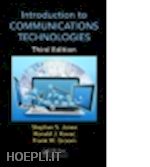Stephan S. Jones, PhD, is the director of the Center for Information and Communication Sciences, where he is also a professor delivering core technology courses in the graduate-only program. His industry experience is as a field engineer and owner of a telecommunications company providing voice and data solutions for business/commercial systems in the Midwest. In academe, he has published or edited numerous books and texts associated with simplifying complex communication technologies for non-engineering students to comprehend. He is actively engaged in supporting broadband technology deployments to underserved and unserved regions of the country and providing technical support for non-profit organizations with student participation. Frank Groom, PhD, is a professor in the Graduate Center for Information and Communication Science at Ball State University. His research is concentrated in the areas of high-bandwidth networking, distributed systems, and the storage of multimedia objects. Dr. Groom is the author of seven books, most recently having finished The Basics of Voice over IP Networking and The Basics of 802.11 Wireless LANs. Among his best known books are The Future of ATM and The ATM Handbook. Dr. Groom earned his PhD from the University of Wisconsin– Milwaukee in information systems. He is the former senior director of information systems for Ameritech. Ron Kovac, PhD, is a full professor in the Center for Information and Communication Sciences at Ball State University in Indiana. The center prepares graduate students in the field of telecommunications. Previous to this position, Dr. Kovac was the telecommunication manager for the state of New York and a CIO for a large computing center located on the east coast. Dr. Kovac’s previous studies included electrical engineering, photography, and education. Dr. Kovac has published two books and over 50 articles and has completed numerous international consulting projects in both the education and telecommunications field. Additionally, he speaks worldwide on issues related to telecommunications and holds numerous certifications, including the CCNA, the CCAI, and the almost complete CCNP. Dr. Kovac is also a Fulbright Scholar and loves life, education and technology.











